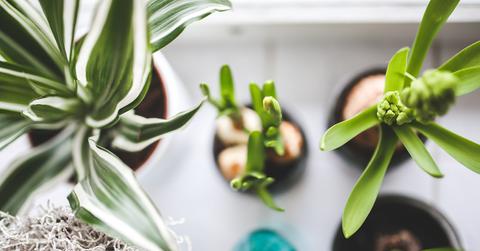These Are The Best Houseplants For Filtering The Air In Your Home
People spend more than 90 percent of their time indoors. But our dwellings are subject to all kinds of air pollutants, from pollen and pet dander to molds and bacteria.
Updated May 21 2019, 4:13 p.m. ET

People spend more than 90 percent of their time indoors. But our dwellings are subject to all kinds of air pollutants, from pollen and pet dander to molds and bacteria. Even upholstery, furniture, cleaning products and synthetic building materials can off-gas toxic compounds. In fact, the Environmental Protection Agency ranked indoor air pollutants among the top-five environmental risks to public health.
Luckily, it’s easy to filter the air in your home with the same air filters the earth relies on: plants. Here are the best plants for filtering out some of the most common indoor air pollutants. And don’t just take our word for it—this list was gleaned NASA research and studies published in the Journal of American Society of Horticultural Science and elsewhere.
Aloe
Aloe is one of those plants that will make you feel like a master gardener with very little effort. You hardly have to water it, it loves to grow, and as long as it’s near a sunny window it’s going to be just fine. It also removes formaldehyde, found in cleaning and personal-care products, toilet paper and tissues from the air. But aloe’s even more of a wonder plant than that: If you didn’t already know, its leaves are walking medicine chests. Crack one open and you’ve got a treatment for cuts, burns, and other minor skin irritations and inflammations.
Azalea
Like aloe, azalea is a great formaldehyde buster. These lovely, flowering shrubs adore humidity and cooler temperatures between 60 and 65 degrees. Keep them away from your heating vents, and mist them instead of watering.
Bamboo Palm
Bamboo palms, also called reed palms, will filter benzene (present in detergents, glues, paints and plastics), formaldehyde and trichloroethylene out of the air. They’ll grow equally in the shade or sun. And as an added bonus, bamboo can grow as tall as 12 feet high and often produce small flowers and berries—turning whatever room they’re in into a beautiful Eden oasis.
Boston Fern
Boston Ferns top the charts for formaldehyde filtration, but also do their part to remove benzene and xylene (a solvent used in the production of leather, printing and rubber) from the air. These ferns are great, but you better be a green thumb—they need regular feedings and waterings, and humid spaces with indirect light.
Chinese Evergreen
The more this plant is exposed to air pollutants, the more it filters. Chinese evergreens will also bloom and berry in low light—just remember to keep them misted.
Chrysanthemum
Mums can filter all kinds of toxins, especially ammonia, benzene, formaldehyde, and xylene and make lovely, flowering air purifiers. The mum’s flowers can keep benzene out of the air and come in just about every color—just keep them in direct sunlight to get them to bloom.
English Ivy
Another formaldehyde remover, English ivy is a great climber that will be beautiful anywhere you train it to grow. The plant can also reduce airborne fecal-matter particles.
Dracaena
Dracaena will take poisons from varnishes and oils like benzene, trichloroethylene and xylene from the air. But if you’ve got pets who like to chew, steer clear of this plant as it can be poisonous to your furry friends. Outside of that, dracaena grows easily and can become taller than 10 feet.
Ficus
Ficus is native to Southeast Asia and grows equally well indoors and out. You can keep it potted all winter long and let it filter benzene, formaldehyde and trichloroethylene from your house, then put it on your deck all summer.
Gerbera Daisy
Gerbers will take out benzene (in many inks) and trichloroethylene (a chemical used by dry cleaners). All they require is well-drained soil and at least six hours of full sun.
Golden Pothos
Another formaldehyde filter, golden pothos will grow in indirect light but can’t be near pets or children, as its leaves themselves are poisonous.
Peace Lily
Peace lilies will knock out ammonia, benzene, formaldehyde, trichloroethylene, xylene, and the VOCs left behind by cleaning products and paint. It’s a great plant for low-light, gives the air some additional humidity, and is awfully easy to grow.
Snake plant
Snake plants are among the hardiest of houseplants and require little water. They’ll help remove pollutants such as benzene, formaldehyde, trichloroethylene, and xylene from the air, so long as you keep them in low light with steamy conditions such as a bathroom.
Spider plant
The spider plant is another one that’s hard to kill. These guys will take on benzene, carbon monoxide, formaldehyde and xylene. They’re also super easy to regrow—just chop off the spiders that spring off the main plant and put them right into another pot.